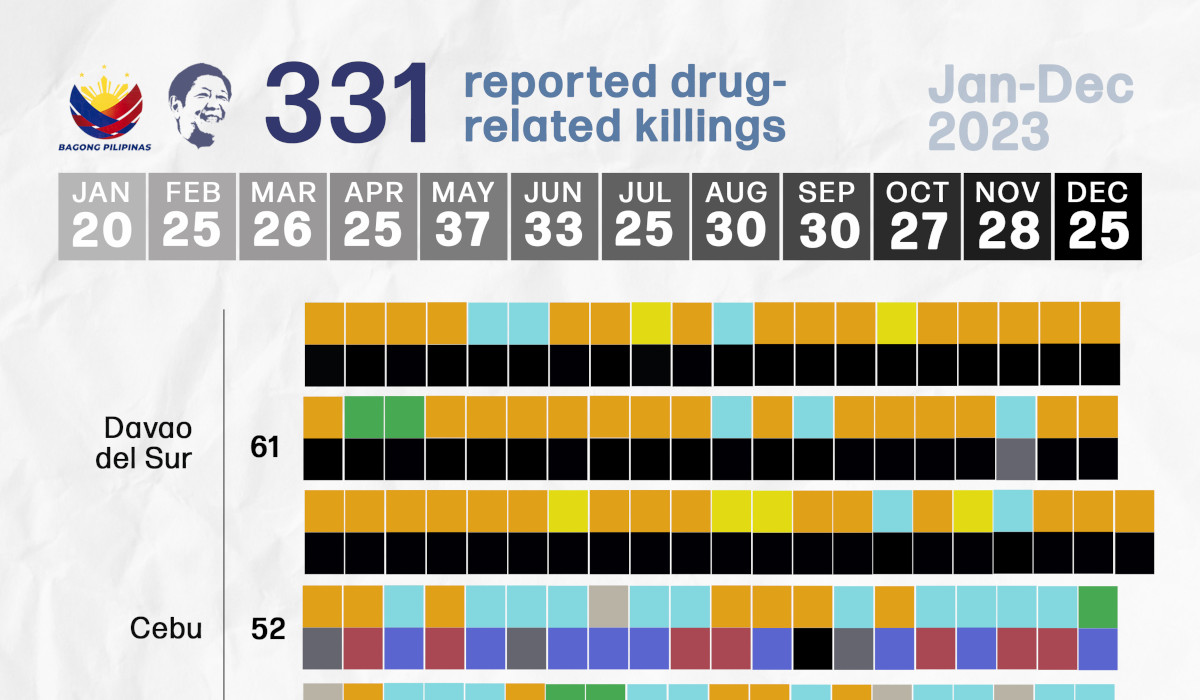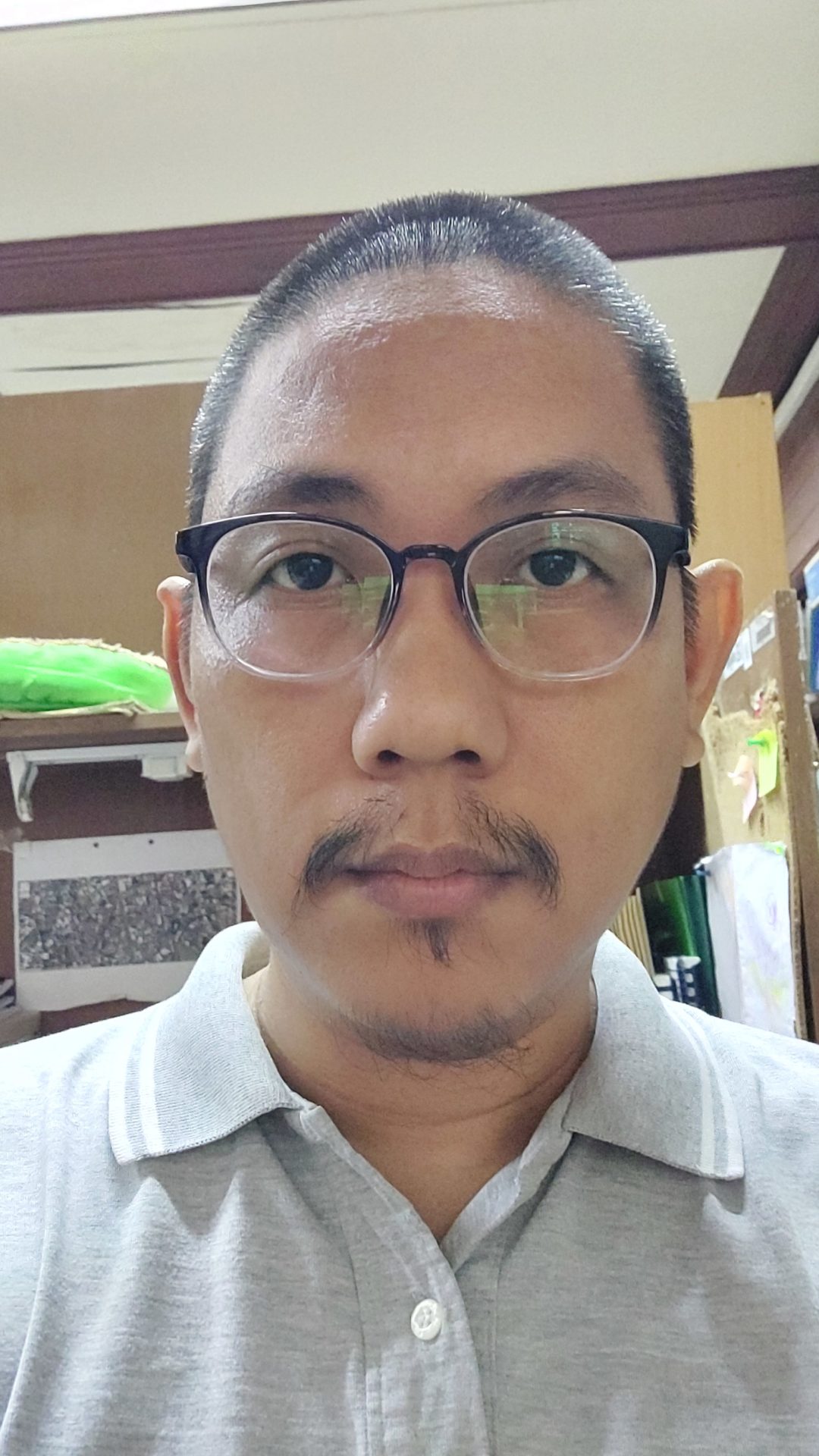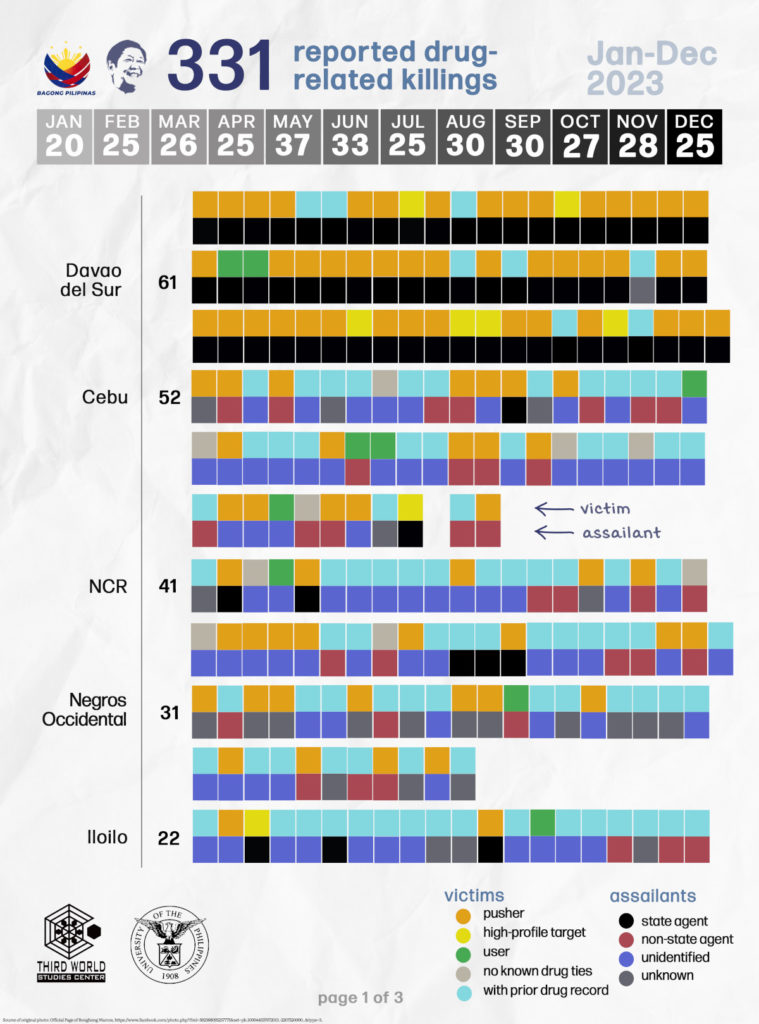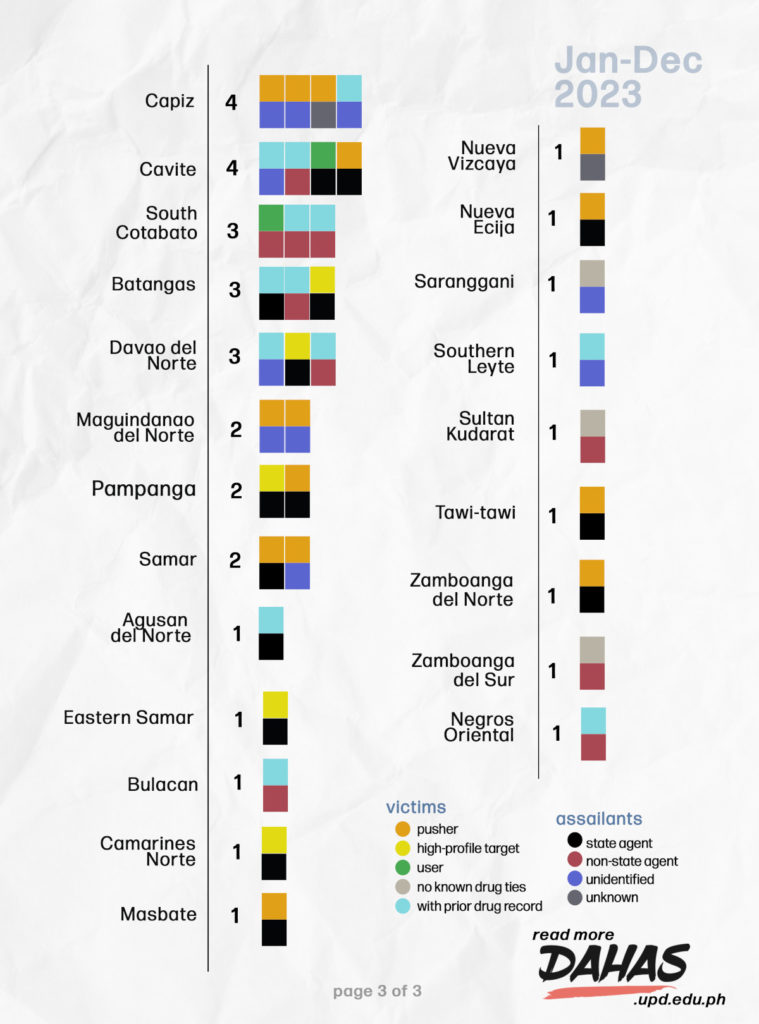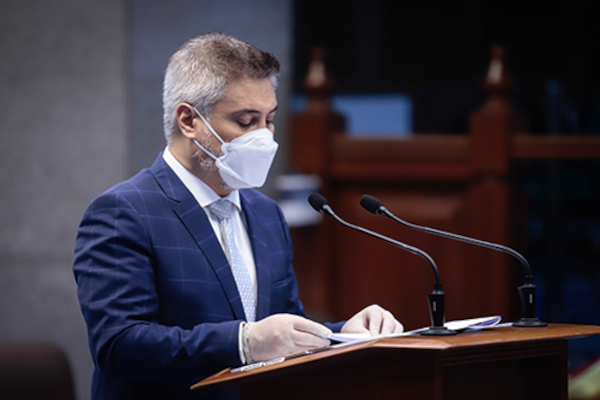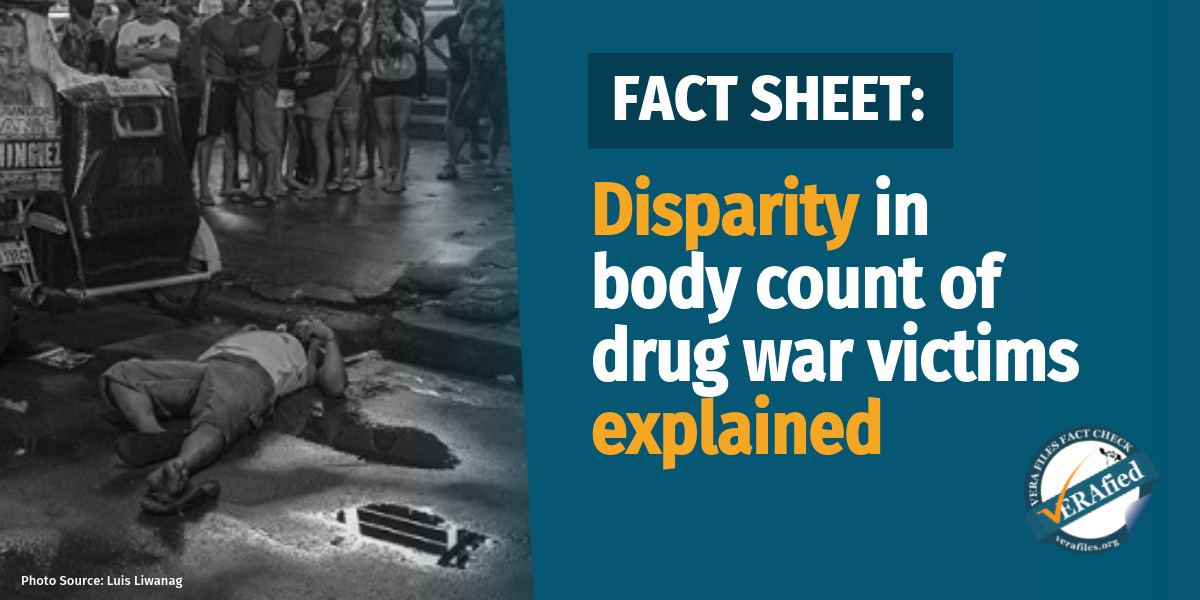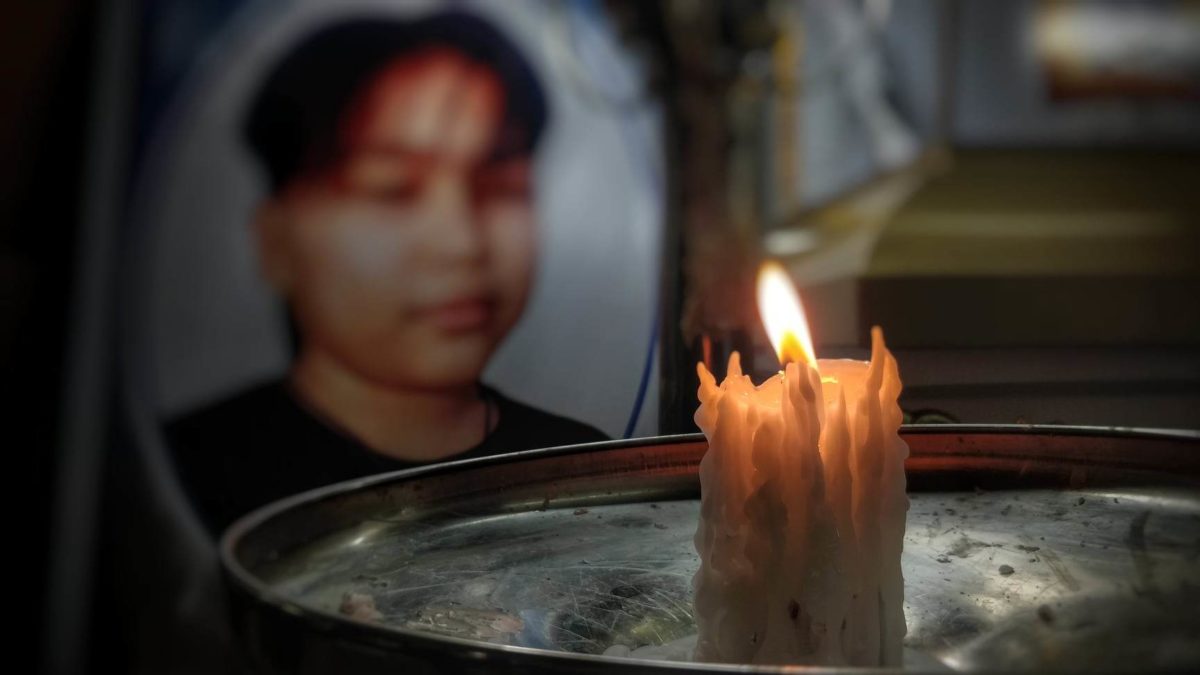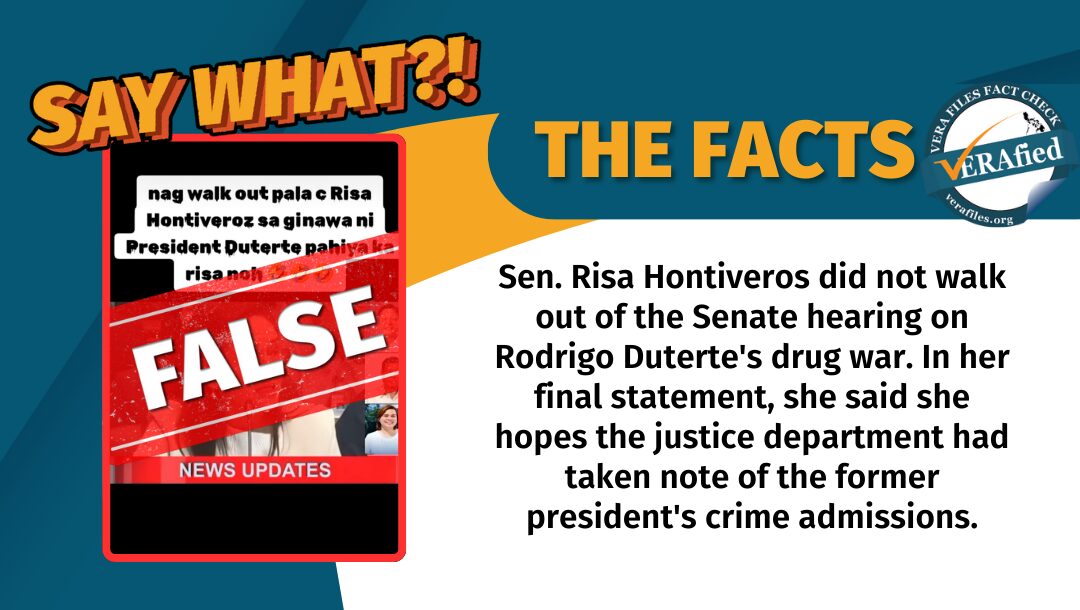Did drug-related killings suddenly stop in 2023 under the Marcos administration?
On January 3, 2024, the Presidential Communications Office issued a news release referencing a report from the Philippine National Police (PNP) touting the administration’s achievements “under President Ferdinand R. Marcos Jr.’s new approach to address the menace.” The piece highlighted the “PhP10.41 billion worth of illegal drugs” that the government confiscated in 2023 and that it has, for the year, “cleared more than 27,000 barangays of narcotics.”
There was no mention of those the Marcos administration killed in its drug war, notwithstanding its rhetoric on repeat that is trying out “new approach to address illegal drugs by focusing on rehabilitation, reintegration, and preventive education programs specifically for the youth.” This is consistent with what President Marcos’s allies in Congress have tried to sell to the public that the Marcos war on drugs is “bloodless.”
Yet news reports from the ground as gathered by our Dahas project and a report from the chief of the PNP himself, offer a grim reminder that drug-related killings continue and that the government is responsible for almost half of it.
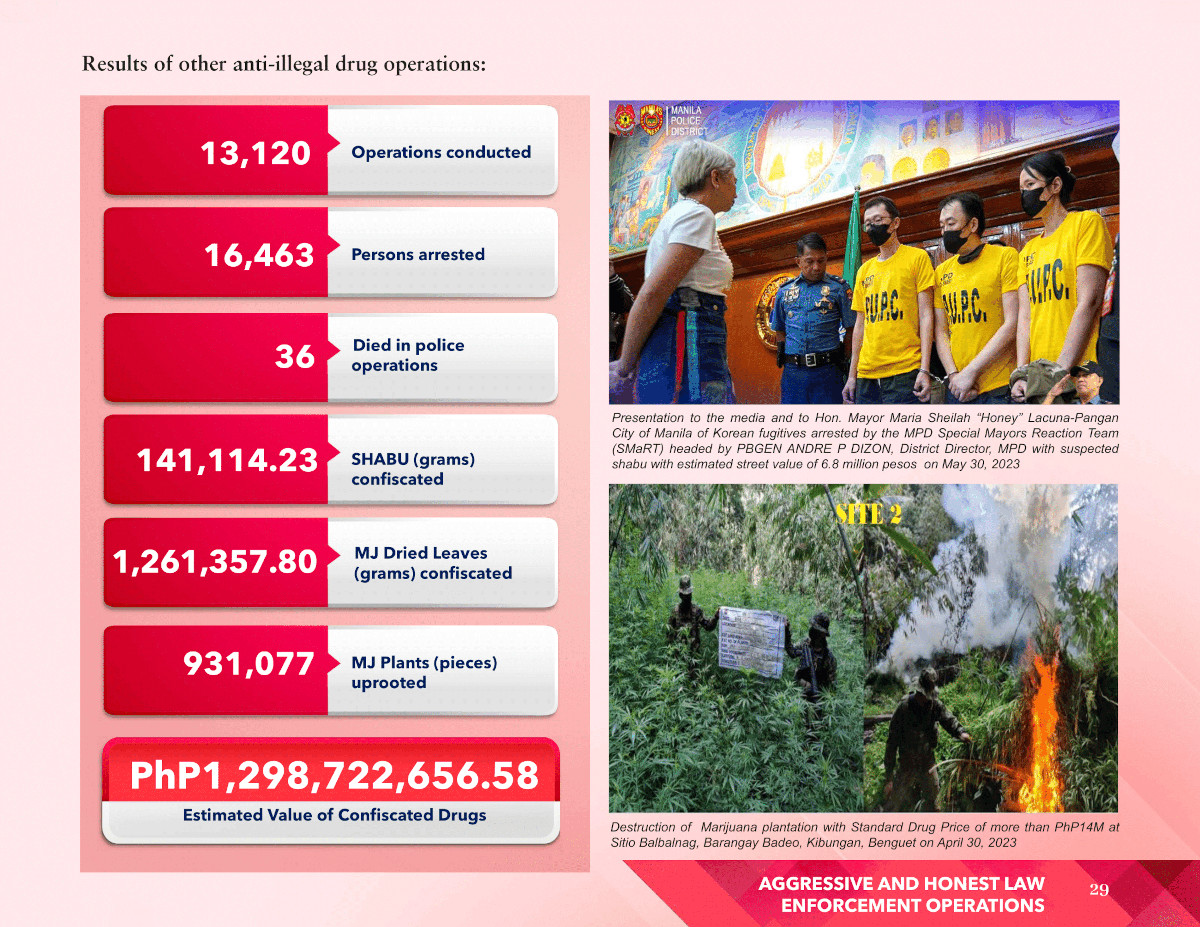
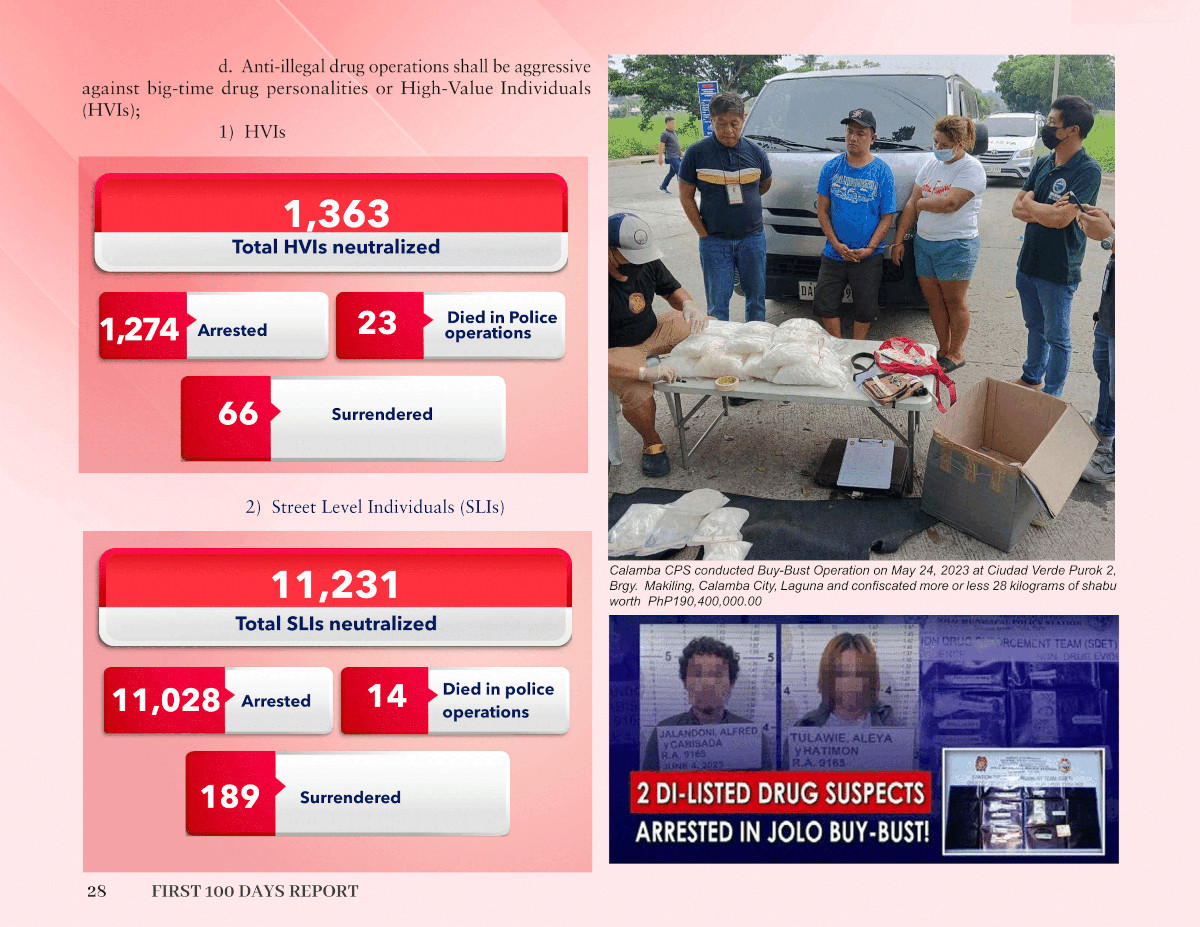
To mark his first 100 days in office (April 24-August 1, 2023) as PNP chief, Police Gen. Benjamin C. Acorda Jr. posted in the PNP official website a report detailing the achievements of the unified police service under his command. Pages 27 to 31 of the report is on action the PNP took to “intensify campaign against illegal drugs.”
The section mentions that 1,363 high-value individuals (HVIs) have been neutralized: 1,274 arrested, 66 surrendered, and 23 “died in police operations.” As for street-level individuals, 11,231 have been neutralized: 11,028 arrested, 189 surrendered, and 14 “died in police operations.” Thirty-six more died as “results of other anti-illegal drug operations.” In sum, from April 24-August 1, 2023, in 100 days, in PNP Chief Acorda’s own account, the police killed 73 individuals in waging its war on drugs.
Our monitoring in Dahas, covering the entire year of 2023, yields a much higher number of casualties: 331. This is 7 more deaths than our total for 2022, which is 324—149 in Duterte’s last 6 months, and 175 in Marcos Jr.’s first.

Dahas’s 2023 casualty count is grouped into five categories: with prior drug record, user, high-profile target, pusher, and no known drug ties.
In Dahas’s monitoring, state agents who were killed in drug-related operations or because of their work in narcotics are counted under the category “no known drug ties.” For 2023, of the 331 casualties, 21 are listed in this category: 7 state agents, 3 police informants, 1 barangay official, 1 former witness in a drug case, and 9 “collateral damage.” Because of their proximity to the main target of the killing or those who were killed because of mistaken identity, they were considered “collateral damage.”
Of the state agents killed, all 7 were members of the PNP. Five of the seven police casualties were killed in buy-bust operations: Police Staff Sgt. Julmakar Paddam Alih was killed in Indanan, Sulu on August 8; Police Chief Master Sgt. Dominic Minaling was killed in Isulan, Sultan Kudarat on October 5; Staff Sergeant Michael Malan was killed in Iloilo City on October 30; Police Staff Sergeant Ryan Languido Baculi was killed in Cebu City on November 15; and just right after Christmas, on December 26, Police Staff Sergeant Richard Rodero was killed in Baao, Camarines Sur.
Two unidentified assailants gunned down Police Senior Master Sergeant Peteselier Licanto on May 17 in General Santos City, possibly due to his work as a member of PNP’s Drug Enforcement Unit. Patrolman Ronnie Revereza Jr. of Naga City, Camarines Sur was fatally shot by a former drug surrenderee on July 6.
On the other side of the divide, 17 users were killed last year. When they were killed, they were found to be in possession of illegal drugs, often shabu or methamphetamine hydrochloride, which by its small amount, is determined to be for personal use.
There were 34 high-value individuals or HVIs killed. These are individuals who are involved in large-scale distribution or are part, if not head, of drug crime groups. Of these 34 HVIs, 11 were killed in Leyte. This number constitutes 68.75 percent of the drug-related killings in the province.
Most of those killed were identified either as pushers or individuals with prior drug records. A victim is categorized under “with prior drug record” if the individual has been convicted in a drug charge, a surrenderee who was subject of local rehabilitation effort, or included in a drug watchlist, among others. Of the 331 fatalities in last year’s drug war, 128 or 38.67 percent fell in this category. Often, they are the victims of unidentified assailants.
Those tagged by police sources in news reports as pushers account for 39.58 percent (131) of the fatalities. Most of them are killed in drug buy-bust operations by the police. They were said to have shot first at the police after they sensed that they were dealing with a cop posing as a buyer. The cops are almost always never hit. But when the cops retaliate on the pusher, death is assured—the now classic “nanlaban” case.
Most of the victims of reported drug-related killings are male, or 298 out of the 331 fatalities or 90.03 percent. There were 30 female casualties, or 9.06 percent of the 2023 total count. The reports on the 3 remaining deaths did not mention their sex.
The age group with the largest number of fatalities were those in their 30s at 82 (24.77 percent), followed by those in their 20s with 54 (16.31 percent); 40s with 49 (14.80 percent); 50s with 17 (5.14 percent); and one in her 60s. For the rest, there was no mention of their age in the reports.
There were 6 fatalities aged 19 and below, 3 of whom were minors. On May 29, assassins killed four individuals, including a 15-year-old boy, in a house in Navotas City. One of the victims was previously arrested for a drug charge. Another incident involved Vincent Repangue Arriesgado, 17 years old and his cousin Jerome Arriesgado, who were fatally shot by men riding-in-tandem in a motorcycle chase on August 2. The police recovered .357 caliber revolvers and packets of shabu from their remains. On December 13, an alleged hitman Joselito Larriba killed 15-year-old Christopher Jose Labor alias “Wawang” for reportedly failing to remit the proceeds from the sale of illegal drugs. On Christmas day, the scheduled day of Labor’s burial, Larriba killed Labor’s mother, Crystal, who was also reported to be previously charged for a drug-related case.

State agents killed 137 or 41.39 percent of the 331 reported drug-related killings, unidentified assailants account for 108 (32.63 percent), non-state agents (they were identified by witnesses) caused 53 deaths (16.01 percent), and unknown assailants (no identification whatsoever, known only by their works, which are mostly body dumps) were responsible for 33 killings or 9.97 percent of all the deaths last year.
The key hotspots for the killings are Davao del Sur, 61; Cebu, 52; Metro Manila, 41; Negros Occidental, 31; and Iloilo, 22.
In Cebu, state agents account for two out of the 52 documented drug-related fatalities. The remaining incidents involved non-state agents, unidentified, and unknown assailants. A comparable pattern can be seen in Manila, where state agents in legitimate operations are responsible for 5 out of 41 deaths.
But Cebu differs from Metro Manila in one thing: police identifying hired killers. In 2023, the police in Cebu tagged at least 8 individuals either as killers or gun-for-hires involved in drug-related killings. Of these assassins, the most recent to be killed is Jenecy Rafols, alias Atong Bacalso Rafols. Rafols killed Police Corporal Ryan Languido Baculi in a failed buy-bust last November 15, 2023. He went into hiding. A warrant was issued for his arrest. Rafols shot at the police serving the warrant in the early morning of December 13, 2023. An officer was hit in the shoulder. The other police officers retaliated and finished him off.
Joselito Larriba, as mentioned above, was caught in a hot pursuit operation for the killings of the mother and son, Christopher Jose and Crystal Mae Labor Ongos.
Jose Roy Bacur Romares shot Jenelyn Belocora in the head on December 23. The police suspected that it was drug-related. The police caught Romares on New Year’s Eve. They alleged that he is a gun-for-hire.
Wilbert Belarmino shot Marvin Caballes on November 19. According to the police, Belarmino was hired for PHP 30,000.00 by a “drug player” inside the Cebu City Jail to kill Caballes for failing to settle a PHP 60,000.00 drug debt.
Godofredo Manzanades shot Paul Jacon (or Jacob) Ebrada multiple times on October 31. The police alleged that Ebrada was involved in illegal drugs. On November 5, Manzanades was said to have shot it out with the cops who were trying to apprehend him. The police said Manzanades is a known gun-for-hire.
Estepan Estrera Canoy, with two other co-conspirators, shot Dhinz Adzyl Abadilla Zabala on September 18. The police caught Canoy and another suspect in the murder of Zabala on September 21. Zabala’s killing was on the order of a “drug lord” already imprisoned at the National Bilibid Prisons. Zabala failed to remit his drug sales.
On May 27, the police caught John Bryan Belamia Fernandez in a buy-bust operation. He confessed to killing three drug pushers who either failed to remit their sales or have misappropriated it. The police said “he works for a known drug lord who is imprisoned in the National Bilibid Prison.” Fernandez was paid PHP 50,000.00 for each kill.
Ricky Lopez Manuel was killed by the police in a buy-bust operation on April 22. Besides being an HVI, the police alleged that “Manuel was involved in the killing of police assets in the region in the past months.”
If Cebu seems to be the place for contract killers to take down erring drug dealers, Davao City is the home of cops who live up to their reputation of being very hands-on when it comes to taking down drug pushers in their city.
In 2023, Davao Del Sur was the country’s top hot spot in reported drug-related killings, where 60 of the 61 killings were done in the context of police operations. The only victim who was not killed by state agents was also the single case that transpired outside Davao City in 2023. Since July last year, we have already highlighted how the killings in “Davao City belie Marcos’ ‘New Face’ approach in fight vs illegal drugs.”
And the police, as the bloody Duterte years have taught them, when they cannot take out someone legally, there is always the extrajudicial option.
On March 26, two killing incidents were reported in Iloilo, with one of the victims identified as 29-year-old Glen Paloma, who was once arrested in a buy-bust operation in 2016 and released via a plea bargaining agreement in 2022. He was abducted, hogtied, and later pushed out of a vehicle and shot repeatedly in a rice field at Barangay Calaboa, Leganes. Initially counted as a fatality by Dahas, it was later revealed that Paloma survived despite sustaining multiple gunshot wounds to his body. Paloma survived the attack and later testified that two of the suspects were Police Executive Master Sgt. Jessie Jim Rubio and Police Staff Sgt. Enrico Gonzales, who were active police officers from the Iloilo City Police Office.
In a January 9, 2024 news release, the Presidential Communications Office quoted President Marcos for having said that his administration has charged “some 177 police officers . . . with drug-related offenses including planting of evidence, unlawful arrest, and excessive violence in Metro Manila alone following a more intensified anti-illegal drugs campaign focusing on law enforcers.”
Who is going to tell him about Davao City?
(Joel F. Ariate Jr. and Larah Vinda Del Mundo are the researchers in charge of the Dahas Project of the Third World Studies Center of the College of Social Sciences and Philosophy, University of the Philippines Diliman. Follow on X (formerly Twitter) the most recent Dahas reports: https://twitter.com/DahasPH.)
